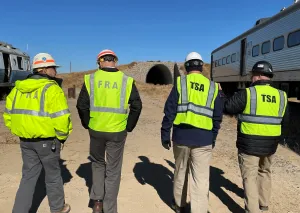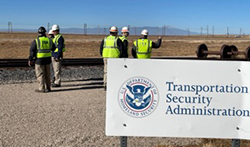
TSA’s partnership with another well-known Department of Homeland Security (DHS) component is alive and well. The close surface transportation partnership with Customs and Border Protection (CBP) was on full display during a trip out west by new TSA Surface Operations Deputy Assistant Administrator Ronald Pavlik Jr.
Pavlik first toured TSA’s Surface Transportation Security Readiness Facility in Pueblo, Colorado, which offers training to federal employees on a wide range of surface transportation issues.
“Most notable are the Introduction to Railroads training courses, which provide an overview of railroad operations and extremely important safety training for those who need to work within and around freight and passenger rail operations,” said TSA Region 4 Security Director for Surface Operations Melvin Carraway, who had the opportunity to lead Pavlik on the tour. “The largest audience for the class are TSA surface inspectors, TSA assistant federal security directors, surface supervisors, Federal Air Marshals and CBP officers responsible for screening rail cars entering the U.S.”
Program Manager Joe McDonough, TSA-contracted instructors and CBP officers team up to lead the class.

Pavlik then traveled to El Paso, Texas, to get an up close look at the Southwest Border Targeting Unit (SBTU), which is part of CBP’s National Targeting Center. The facility’s goal is to enhance rail, trucking, bus, maritime and pipeline security. Carraway said TSA and CBP partners with multiple agencies to ensure “the domestic freedom of movement for people and commerce.”
“Embedded with CBP are special agents from Homeland Security Investigations and two transportation security specialists (TSS) who collaborate with surface transportation stakeholders, ports of entry, territorial entities and other government agencies to mitigate potential threats emerging from outside the United States,” explained Carraway. “Collectively, the SBTU team provides assistance in the form of advanced targeting, analysis and the development of products to inform the field on current and new trends.”
TSS Brian Anderson helped stand up TSA’s presence at the SBTU in 2015 and has developed many of the programs that leverage the strengths of each agency to support TSA and CBP field personnel. TSS Dina Ibarra joined the team in 2020 and has developed new ways to enhance both agencies’ missions.
“Without a team like the SBTU, coordinated efforts and information sharing between the agencies may not occur in the surface transportation environment,” Carraway noted. “The partnership and collaboration between TSA and DHS is important, as they have interconnected missions pertaining to the safe movement of surface transportation and the American people.”
By Don Wagner, TSA Strategic Communications & Public Affairs
Related Stories: Senior Leaders Get Up Close Look at ‘One of TSA’s Best Secrets’
TSA Partnerships Flourish in Houston
